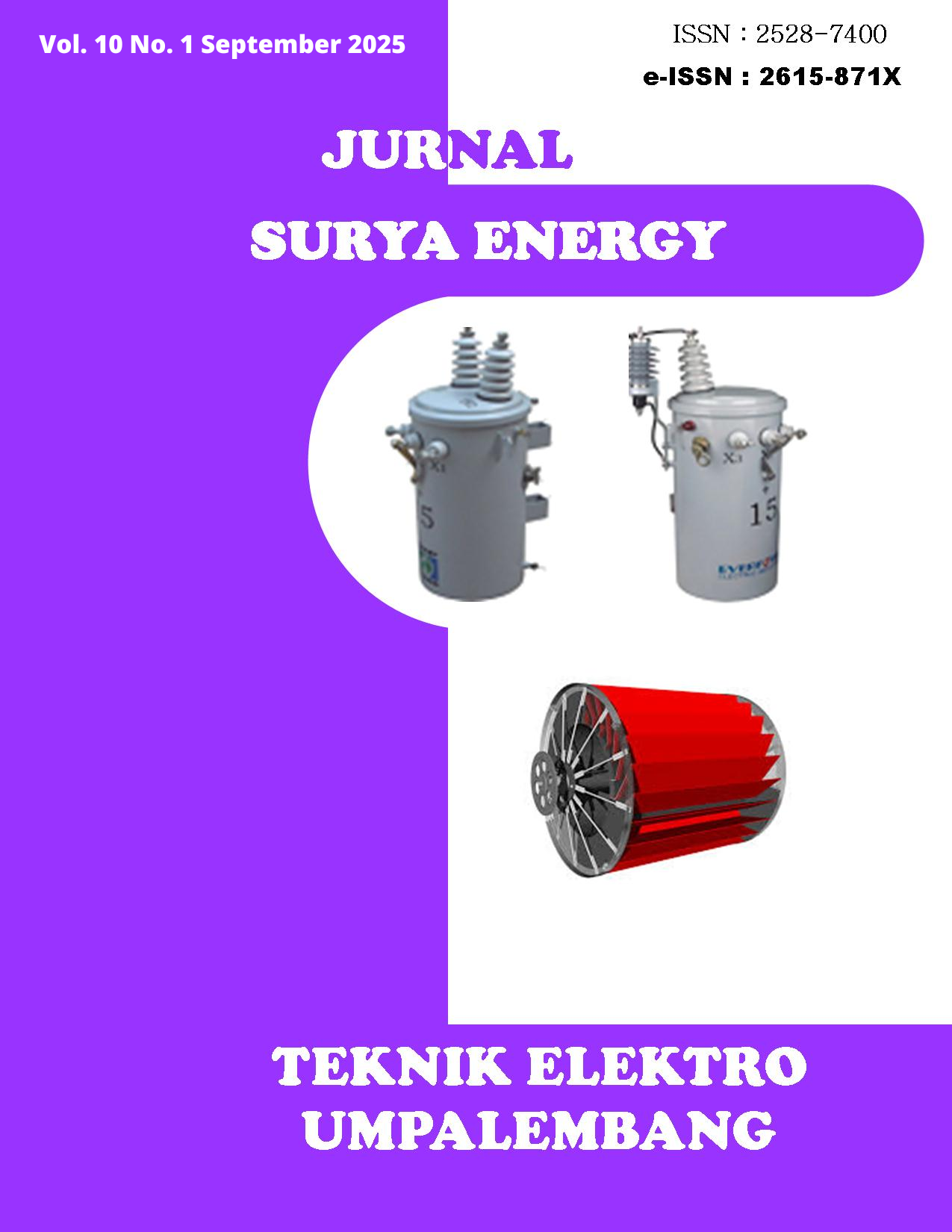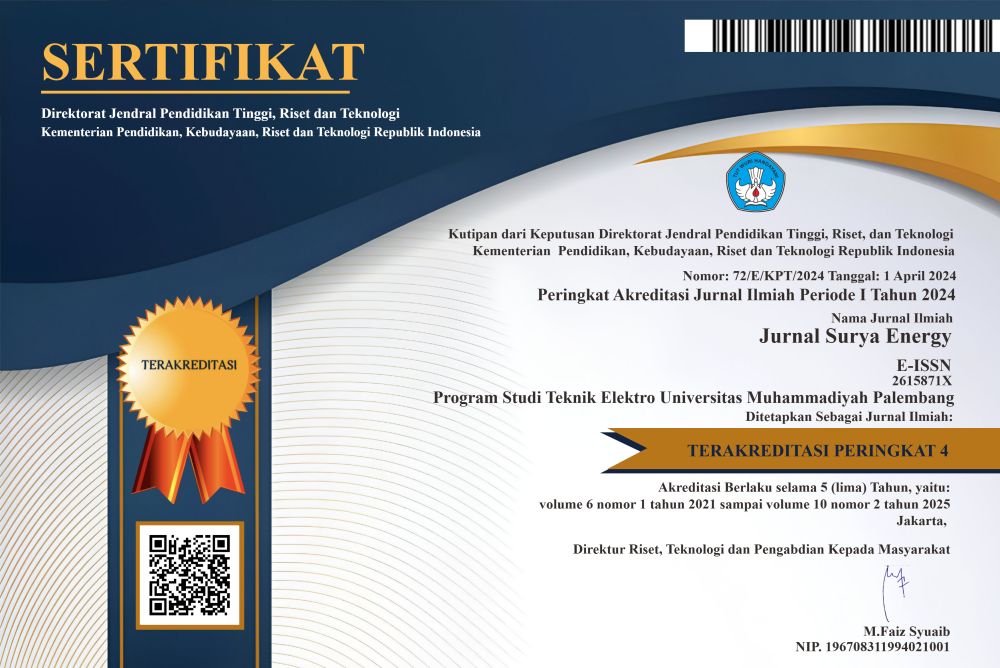Solar Power Installation Simulation in SDN Rancagong 1 and 4 Using PVSyst to Support the Physical Standard of Comfort
DOI:
https://doi.org/10.32502/jse.v10i1.547Keywords:
Physical Comfort, Electricity, Solar Energy, PVSystAbstract
Physical comfort in the learning environment relies on the use of good electrical equipment, which significantly supports the learning process. To enhance comfort, it is essential to maximize the use of electrical appliances, although this can lead to increased energy consumption. Most of the primary energy for power generation comes from non-renewable sources, which contribute to pollution. In Indonesia, not all regions have access to electricity that meets desired comfort standards. One such area is SDN Rancagong 1 and 4, where the use of power tools to support the learning process is still minimal. Measurements of comfort standards revealed that the air temperature exceeded the SNI 03-6572-2001 standard by 4°C, while humidity levels surpassed the same standard by 9%. Additionally, illumination levels were less than a third of the SNI 6072-2020 lighting standard. Qualitative feedback from room occupants supports these findings. To address these issues, the proposal includes the use of renewable energy sources such as solar energy. To avoid losses and ensure effective implementation, simulations were conducted using PVSyst software. The results indicated a power generation potential of 7,829.33 kWh per year, with a performance ratio of 49%, a solar fraction of 100%, an SOW cycle of 98.4%, and a static SOW of 90%. With this power output, it is anticipated that electricity can be provided for equipment that enhances comfort standards, such as air conditioning and additional lighting.
References
Ahlawat, A., Wiedensohler, A., & Mishra, S. K. (2020). An overview on the role of relative humidity in airborne transmission of sars-cov-2 in indoor environments. Aerosol and Air Quality Research, 20(9), 1856–1861. https://doi.org/10.4209/aaqr.2020.06.0302
Ahmad, O. A., Habeeb, W. H., Mahmood, D. Y., Jalal, K. A., & Sayed, H. (2019). Design and performance analysis of 250 kw grid-connected photovoltaic system in iraqi environment using pvsyst software. Indonesian Journal of Electrical Engineering and Informatics, 7(3), 415–421. https://doi.org/10.11591/ijeei.v7i3.978
Alotaibi, B. S., Lo, S., Southwood, E., & Coley, D. (2020). Evaluating the suitability of standard thermal comfort approaches for hospital patients in air-conditioned environments in hot climates. Building and Environment, 169, 106561. https://doi.org/10.1016/J.BUILDENV.2019.106561
Atsauri, N., Muldjono, A. B., & Natsir, A. (2021). The capacity design of Solar Rooftop Power Plant on Building C Faculty of Engineering.
Bei, J., & Wang, C. (2023). Renewable energy resources and sustainable development goals: Evidence based on green finance, clean energy and environmentally friendly investment. Resources Policy, 80, 103194. https://doi.org/10.1016/J.RESOURPOL.2022.103194
Boyce, P. R., Brandston, H. M., & Cuttle, C. (2022). Indoor lighting standards and their role in lighting practice. Lighting Research & Technology, 54(7), 730–744. https://doi.org/10.1177/14771535221126413
Gago, E. J., Muneer, T., Knez, M., & Köster, H. (2015). Natural light controls and guides in buildings. Energy saving for electrical lighting, reduction of cooling load. Renewable and Sustainable Energy Reviews, 41, 1–13. https://doi.org/10.1016/J.RSER.2014.08.002
Grover, A., Khosla, A., & Joshi, D. (2020). Design and simulation of 20MW photovoltaic power plant using PVSyst. Indonesian Journal of Electrical Engineering and Computer Science, 19(1), 58–65. https://doi.org/10.11591/ijeecs.v19.i1.pp58-65
Khair, A., & Ashari, H. (2021). Studi Prediksi Penggunaan Energi Listrik di Desa Sanglepongan Kabupaten Enrekang Dengan Menggunakan Metode Moving Average (MA) (Vol. 18, Issue 2).
Kurniawan, D. E., Iqbal, M., Friadi, J., Borman, R. I., & Rinaldi, R. (2019). Smart Monitoring Temperature and Humidity of the Room Server Using Raspberry Pi and Whatsapp Notifications. Journal of Physics: Conference Series, 1351(1), 012006. https://doi.org/10.1088/1742-6596/1351/1/012006
Langer, J., Quist, J., & Blok, K. (2021). Review of Renewable Energy Potentials in Indonesia and Their Contribution to a 100% Renewable Electricity System. Energies, 14(21). https://doi.org/10.3390/en14217033
Michael, A., & Heracleous, C. (2017). Assessment of natural lighting performance and visual comfort of educational architecture in Southern Europe: The case of typical educational school premises in Cyprus. Energy and Buildings, 140, 443–457. https://doi.org/10.1016/J.ENBUILD.2016.12.087
Mishra, P. R., Rathore, S., & Jain, V. (2024). PVSyst enabled real time evaluation of grid connected solar photovoltaic system. International Journal of Information Technology, 16. https://doi.org/10.1007/s41870-023-01677-x
Parkinson, T., de Dear, R., & Brager, G. (2020). Nudging the adaptive thermal comfort model. Energy and Buildings, 206, 109559. https://doi.org/10.1016/J.ENBUILD.2019.109559
Peraturan Menteri Energi Dan Sumber Daya Mineral Repuiblik Indonesia Nomor 13 Tahun 2012 Tentang Penghematan Pemakaian Tenaga Listrik, Pub. L. No. 13 (2012). https://migas.esdm.go.id/uploads/regulasi/profil_peraturan_304.pdf
Pranata, N., & Salehuddin, M. (2024). Field Assessment for Initial Preparation of Net Zero Building Certification for The Universitas Multimedia Nusantara (UMN) Building: A Case Study On Visual Comfort in C and D Tower. Ultima Computing : Jurnal Sistem Komputer, 16(1).
PVSyst. (2023). Validations. https://www.pvsyst.com/help/validations.htm.
Ryan Restyawan. (2017). Sistem Informasi Kepegawaian. https://dspace.uii.ac.id/bitstream/handle/123456789/10067/10523193%20-%20Ryan%20Restyawan%20-%20Sistem%20Informasi%20Kepegawaian.pdf?sequence=11&isAllowed=y
Saleem, A. A., Bady, M., Ookawara, S., & Abdel-Rahman, A. K. (2016). Achieving standard natural ventilation rate of dwellings in a hot-arid climate using solar chimney. Energy and Buildings, 133, 360–370. https://doi.org/10.1016/J.ENBUILD.2016.10.001
Saputri, F. R., Pranata, N., & Dwiputra, F. (2023a). Analysis of Solar Power Plant Design Using RETScreen and PVSyst in Pekanbaru- Indonesia. 2023 13th International Conference on Power, Energy and Electrical Engineering (CPEEE), 496–500. https://doi.org/10.1109/CPEEE56777.2023.10217460
Saputri, F. R., Pranata, N., & Dwiputra, F. (2023b). Analysis of Solar Power Plant Design Using RETScreen and PVSyst in Pekanbaru- Indonesia. 2023 13th International Conference on Power, Energy and Electrical Engineering (CPEEE), 496–500. https://doi.org/10.1109/CPEEE56777.2023.10217460
Sharma, R., Shahbaz, M., Kautish, P., & Vo, X. V. (2021). Does energy consumption reinforce environmental pollution? Evidence from emerging Asian economies. Journal of Environmental Management, 297, 113272. https://doi.org/10.1016/J.JENVMAN.2021.113272
Standar Tingkat Pencahayaan SNI 6197 2020 (2020).
Stefani, O., & Cajochen, C. (2021). Should We Re-think Regulations and Standards for Lighting at Workplaces? A Practice Review on Existing Lighting Recommendations. Frontiers in Psychiatry, 12. https://doi.org/10.3389/fpsyt.2021.652161
Sumbung, F., Letsoin, Y., & Hardiantono, D. (2016). Penentuan Kapasitas dan Karakteristik Modul PV Pada Perencanaan Pembangunan PLTS Komunal di Distrik Okaba. MUSTEK ANIM HA, 5(2). https://doi.org/10.35724/mustek.v5i2.623
Suriadi, & Mahdi Syukri. (2010). (PLTS) Terpadu Menggunakan Software PVSYST Pada Komplek Perumahan di Banda Aceh. Jurnal Rekayasa Elektrika, 9(2). https://doi.org/://doi.org/10.17529/jre.v9i2.167
Wojnicki, I., Komnata, K., & Kotulski, L. (2019). Comparative Study of Road Lighting Efficiency in the Context of CEN/TR 13201 2004 and 2014 Lighting Standards and Dynamic Control. Energies, 12(8). https://doi.org/10.3390/en12081524
Downloads
Published
How to Cite
Issue
Section
License
Copyright (c) 2025 Nicholas Pranata, Niki Prastomo, Vincentius Rayza Lee, Ricardo Linelson

This work is licensed under a Creative Commons Attribution-ShareAlike 4.0 International License.











